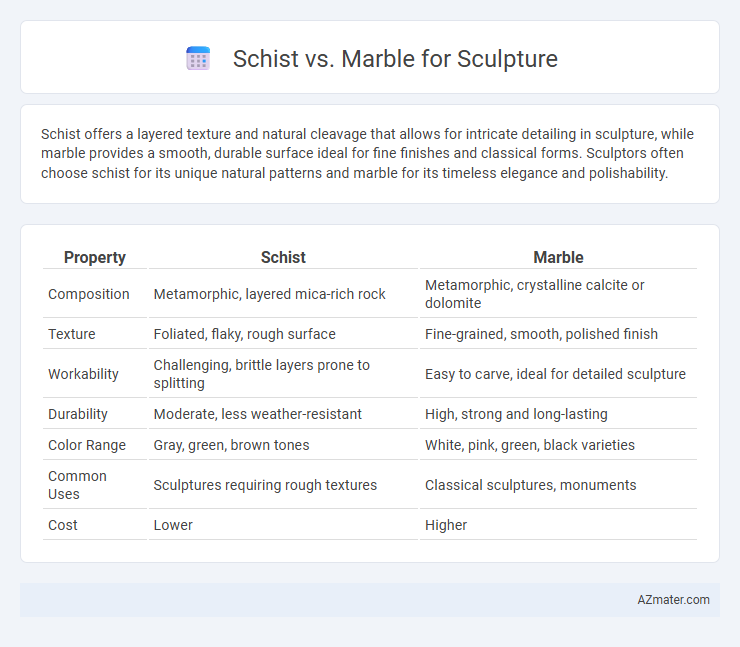Schist offers a layered texture and natural cleavage that allows for intricate detailing in sculpture, while marble provides a smooth, durable surface ideal for fine finishes and classical forms. Sculptors often choose schist for its unique natural patterns and marble for its timeless elegance and polishability.
Table of Comparison
| Property | Schist | Marble |
|---|---|---|
| Composition | Metamorphic, layered mica-rich rock | Metamorphic, crystalline calcite or dolomite |
| Texture | Foliated, flaky, rough surface | Fine-grained, smooth, polished finish |
| Workability | Challenging, brittle layers prone to splitting | Easy to carve, ideal for detailed sculpture |
| Durability | Moderate, less weather-resistant | High, strong and long-lasting |
| Color Range | Gray, green, brown tones | White, pink, green, black varieties |
| Common Uses | Sculptures requiring rough textures | Classical sculptures, monuments |
| Cost | Lower | Higher |
Introduction to Schist and Marble in Sculpture
Schist and marble are both popular materials in sculpture, each offering unique characteristics that influence an artist's choice. Schist is a metamorphic rock known for its foliated texture and layered appearance, making it suitable for sculptures requiring intricate detailing and rough textures. Marble, a crystalline metamorphic rock formed from limestone, is prized for its smooth surface, durability, and ability to achieve fine polish, often used in classical and high-finish sculptures.
Geological Origins and Composition
Schist, a metamorphic rock formed from mudstone or shale under medium to high-grade metamorphism, contains abundant mica minerals that provide its characteristic foliated texture ideal for detailed sculpting. Marble originates from the metamorphism of limestone or dolostone, primarily composed of recrystallized calcite or dolomite crystals, offering a smooth, homogenous surface preferred for classical and refined sculptures. The differences in mineral composition and foliation influence the carving techniques and final appearance, with schist providing more texture and marble delivering a polished aesthetic.
Physical Properties: Strength and Texture
Schist offers a coarse-grained texture with visible mineral flakes, providing a natural, rugged appearance ideal for rustic sculptures, but its foliation planes reduce overall strength and make it prone to splitting. Marble, composed primarily of recrystallized calcite, exhibits a fine-grained, smooth texture that allows for intricate detailing and a polished finish, combined with high compressive strength that ensures durability in sculptural works. The choice between schist and marble largely depends on desired aesthetic effects and structural requirements, with marble favored for longevity and precision, while schist is selected for textural complexity and visual interest.
Workability for Sculptors
Schist offers medium workability for sculptors due to its foliated structure, allowing detailed carving but requiring careful handling to avoid splitting. Marble provides superior workability with its fine-grained, homogenous texture that enables smooth, precise sculpting and polishing. Sculptors often prefer marble for intricate details and a refined finish, while schist is chosen for its unique texture and affordability.
Aesthetic Qualities and Visual Appeal
Schist offers a unique aesthetic with its layered texture and natural shimmering mica, providing sculptures a raw, earthy appeal that emphasizes rugged beauty and organic patterns. Marble is renowned for its smooth, translucent surface and classic white or colored veining, giving sculptures a refined, elegant look that highlights fine detail and timeless sophistication. The choice between schist and marble depends on the desired visual impact--schist delivers a textured, dynamic presence, while marble ensures polished, high-contrast clarity in sculptural art.
Durability and Weather Resistance
Schist exhibits moderate durability with a layered structure that can be prone to flaking and erosion over time, making it less ideal for outdoor sculptures exposed to harsh weather conditions. Marble offers superior weather resistance and durability due to its dense, crystalline composition, allowing it to withstand freeze-thaw cycles and acid rain more effectively. Sculptors seeking longevity and minimal maintenance in outdoor installations often prefer marble for its enduring strength and resilience.
Historical Usage in Sculpture
Schist and marble have both played significant roles in the history of sculpture, with marble favored by ancient Greeks and Romans for its fine grain and ability to hold intricate detail. Schist, characterized by its layered texture and natural cleavage planes, was often used in regions where marble was scarce, such as in parts of the Middle East and South Asia, contributing to local sculptural traditions. The durability and aesthetic qualities of marble made it the material of choice for classical statues and monumental works, while schist's unique textural properties offered distinctive visual effects in regional artworks.
Cost and Availability of Materials
Schist is generally more affordable and widely available than marble, making it a cost-effective choice for sculptors on a budget. Marble, renowned for its fine grain and durability, is often more expensive due to quarrying complexities and limited high-quality deposits. Availability of marble varies significantly by region, with countries like Italy and Greece being notable sources, whereas schist can be sourced more broadly, contributing to its lower cost and accessibility.
Notable Works and Artists
Schist, known for its layered texture and durability, was favored by ancient sculptors such as the Egyptians, who utilized it in stelae and relief carvings, notably in the tomb of Pharaoh Mentuhotep II. Marble, prized for its fine grain and translucency, became the medium of choice during the Renaissance, with masters like Michelangelo creating iconic sculptures including the David and the Pieta. Contemporary artists continue to exploit marble's versatility, while schist remains valued for its unique aesthetic and weather resistance in outdoor installations.
Choosing the Right Stone for Your Sculpture
Schist offers a textured surface and natural layering, making it ideal for sculptures requiring intricate detail and a rustic appearance. Marble, prized for its smoothness and fine grain, allows for precise carving and is favored for classical, polished sculptures that emphasize elegance. Selecting the right stone depends on the desired aesthetic, durability needs, and the sculptor's technique, with marble suited for refined finishes and schist for rugged, textured effects.

Infographic: Schist vs Marble for Sculpture
 azmater.com
azmater.com